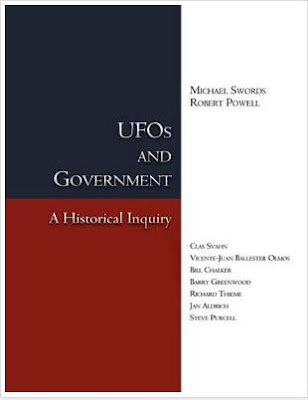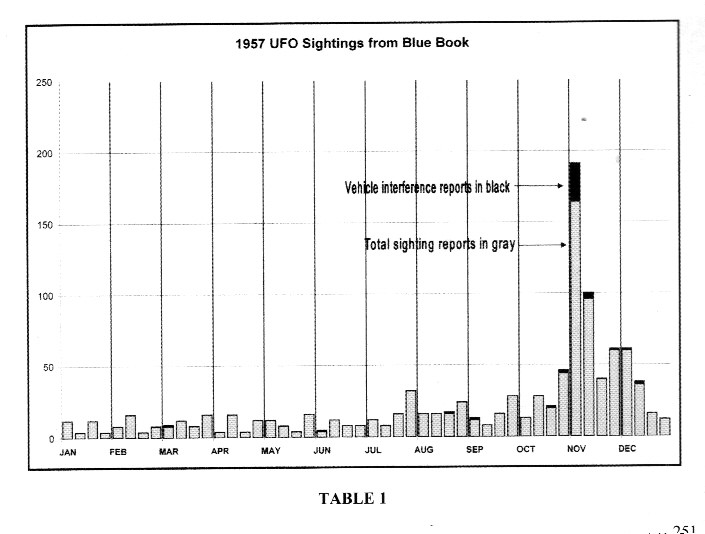 UFOS AND GOVERNMENT amazon.com/UFOs-Government-Historical-Michael-Swords |
 |
|
In the latter part of 1957, due to the
International Geophysical Year and the
launchings of the Soviet satellites, a program
was initiated that drove many people outdoors,
looking at the sky. The program was called
Operation Moonwatch. Moonwatch was mainly composed of amateurs under the supervision of the Smithsonian Astrophysical Observatory (SAO), directed by Harvard meteor expert, Dr. Fred Whipple, and assisted by J. Allen Hynek. Moonwatch's goal was the accurate plotting of Soviet and U.S. satellite orbits.48 The program was supported by some excellently-designed tracking telescopes, the "Baker-Nunn" cameras. People were excited about the human race breaking into space, and many persons volunteered. As far as UFOs were concerned, this project
put many trained and semi-trained observers into
place to scan the heavens. From most viewpoints
this was a good thing, but not necessarily to
the Air Force.They did not want more UFO stories
coming in from a government program. In
practice, things should have been fairly well
controlled. Project Director Whipple was Donald
Menzel’s closest friend on the Harvard Astronomy
Staff and a consultant to Blue Book. What could
be a better-controlled situation? As it turned
out, the situation could have been much better
for the Air Force. Citizens talked, and Allen
Hynek began to let his curiosity get the better
of himself. Hynek began to think that, at a
minimum, there were things in the UFO
observations that pointed to at least one new
natural phenomenon, if not several. Whereas some
higher personnel in the SAO Moonwatch
organization did not want citizen observers to
log “unidentifieds” even if they obviously were
not satellites, Hynek wanted the cases and
he was not alone.49 One of his assistants,
Bud Ledwith, was very interested; so was a young
apprentice named Walter Webb. Both went on to do
research on UFOs beyond Moonwatch, and Webb made
a lifetime of it. So signals to the citizen
observers were mixed. Many logs of unidentified
“non-satellites” were received. Doubtless more
were never logged. Hynek gathered additional
information by “personal communication.” But
these observations were generally kept very
quiet. Only in later years would anybody outside
the SAO, Hynek, Webb, et al., have any inkling
of the numbers. It is a story still untold. But
we will tell a little of that story in the next
chapter. Suffice it to say for now that in those
times the science media used Moonwatch as an
argument against UFOs: with so many trained
observers looking, surely Moonwatch would have
seen unidentified objects if there were any;
and, of course, they have not.50 It was just one
more peculiar untruth in what seems to be an
endless continuous stream of disinformation.
Sputnik went up in early October and so did
UFO reports. Some commentators say that those
reports were Soviet hysteria; some say it was
just because people were outside looking for
Sputnik. In October, reports were about twice
what the earlier months averaged, but when the
1957 flap occurred in early November, the cases
shot up to ten times the earlier rate.51 The
flap is much too dense and powerful to describe
thoroughly in a few pages here. Instead, our
coverage of the flap will concentrate upon two
main topics: how the phenomenon, for the first
time in the United States, “came closer,”
manifesting itself with “close encounters”
involving physical effects on both technology
and people; and how the government dealt with
these issues to keep the country from becoming
too excited or frightened.
Table 1 shows what the Air Force had to deal with
as the number of cases exploded.52 It represents
what UFOlogists would call a concentrated national
“flap.” The year 1957 was proceeding fairly
quietly until the very end of October. Then case
reports rocketed off the chart, spiking on the 5th
and 6th of November. The rate of incidents was far
beyond the capability of the Air Force to properly
investigate. And this flap was distinctively
different. Hidden within the sheath of
old-fashioned UFO reports was the sharp blade of a
new (for the United States) phenomenology: close
encounters. These close encounters mainly bore a
distinct characteristic: the failures of
automobile engines (and often other devices, such
as lights and radios) that were coincident with
the presence of an unidentified object, and felt
by the witness to be due to that object. Also
embedded in the flap, in lesser, but still
interesting, amounts, were several cases in which
the witnesses seemed to have received a mild
“burn” from the light, heat, or other radiation
from the offending object. Both of these
UFO-related or UFO coincident phenomena were very
rare in previous American records. Both of these
were much more personal and potentially
threatening than what military and civilians had
typically dealt with before. How would the
citizenry react? How would the military?   All of this is part of the mystery: each era
is partly distinctive, partly the same. The
sameness would lead students towards linking the
phenomenology, the differences to tearing the
phenomenology apart. It was always this latter
elementthat the phenomenon would not present a
tight, predictable patternthat had been the
strongest Air Force tool for arguing against it,
and the argument that was featured in Blue Book
14. But sometimes intensity will overcome
everything else, and this was an intense flap
with spectacular aspects. How would it play out?
Earlier in the year (August 22, near Cecil
Naval Air Station, Florida),54 Blue Book had
become aware of an isolated case of a vehicle
stoppage and had written it off as the sighting
of a helicopter (ignoring the car engine
problem). Earlier still, several
radar-interference cases caused some to think
that UFOs could generate electromagnetic
radiation, perhaps even as directional pulses.55
Of course, no one was yet thinking about UFO
electromagnetic pulses stopping automobile
engines, but, as time went on, UFO researchers
would wonder about this and government labs
(such as Los Alamos and Sandia) would initiate
research programs on such things as a non-lethal
battlefield tool.56 All of this gained a feeling
of concrete reality in Western Texas on the
night of November 2 and 3.
|